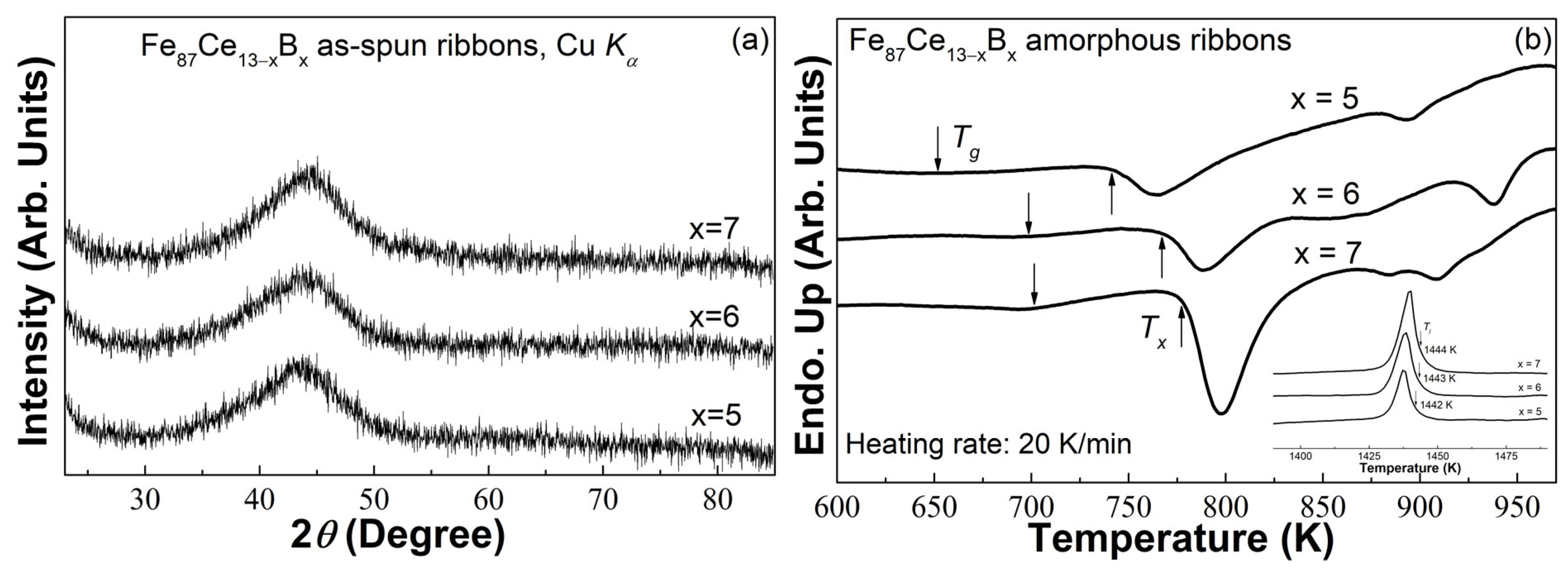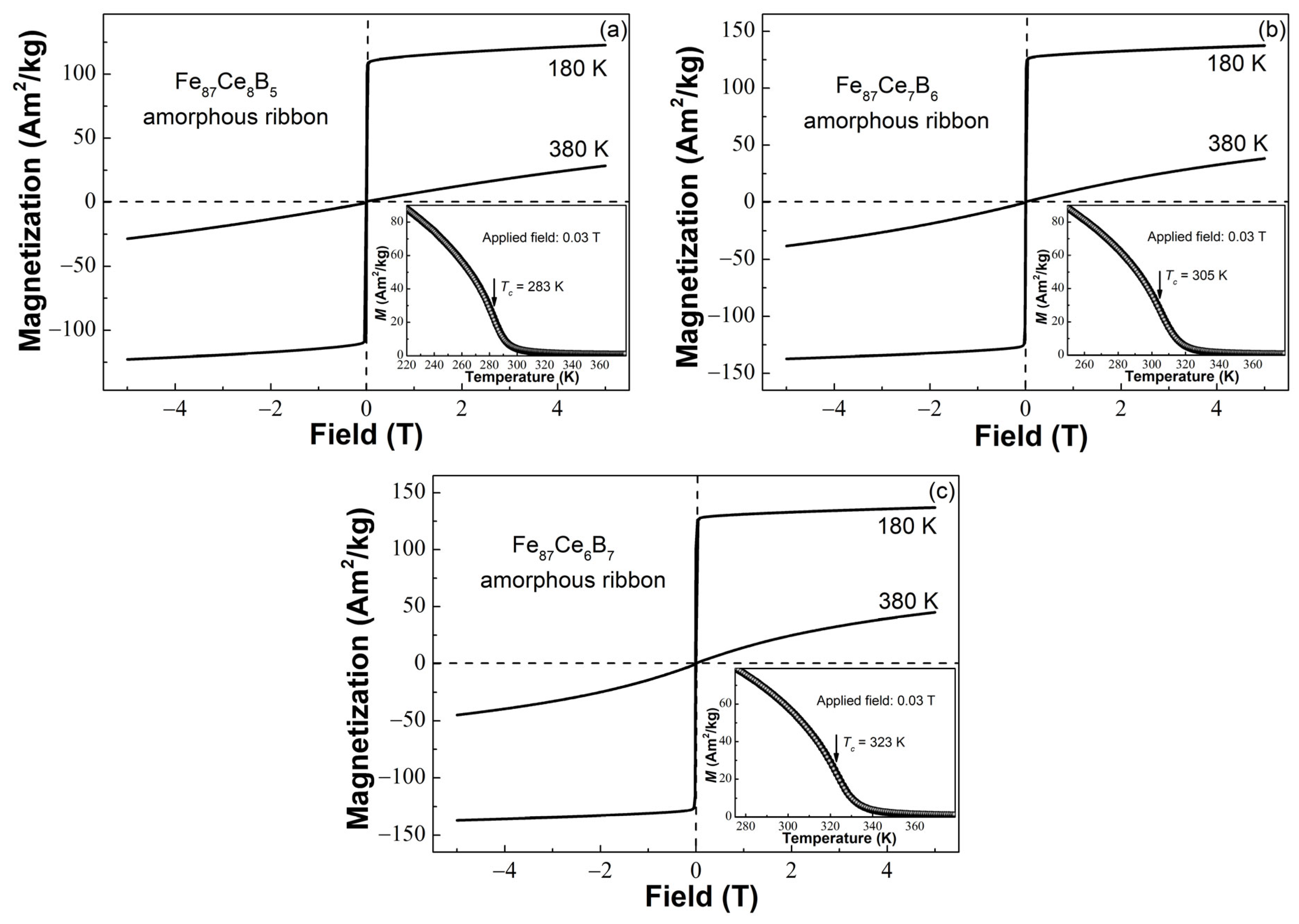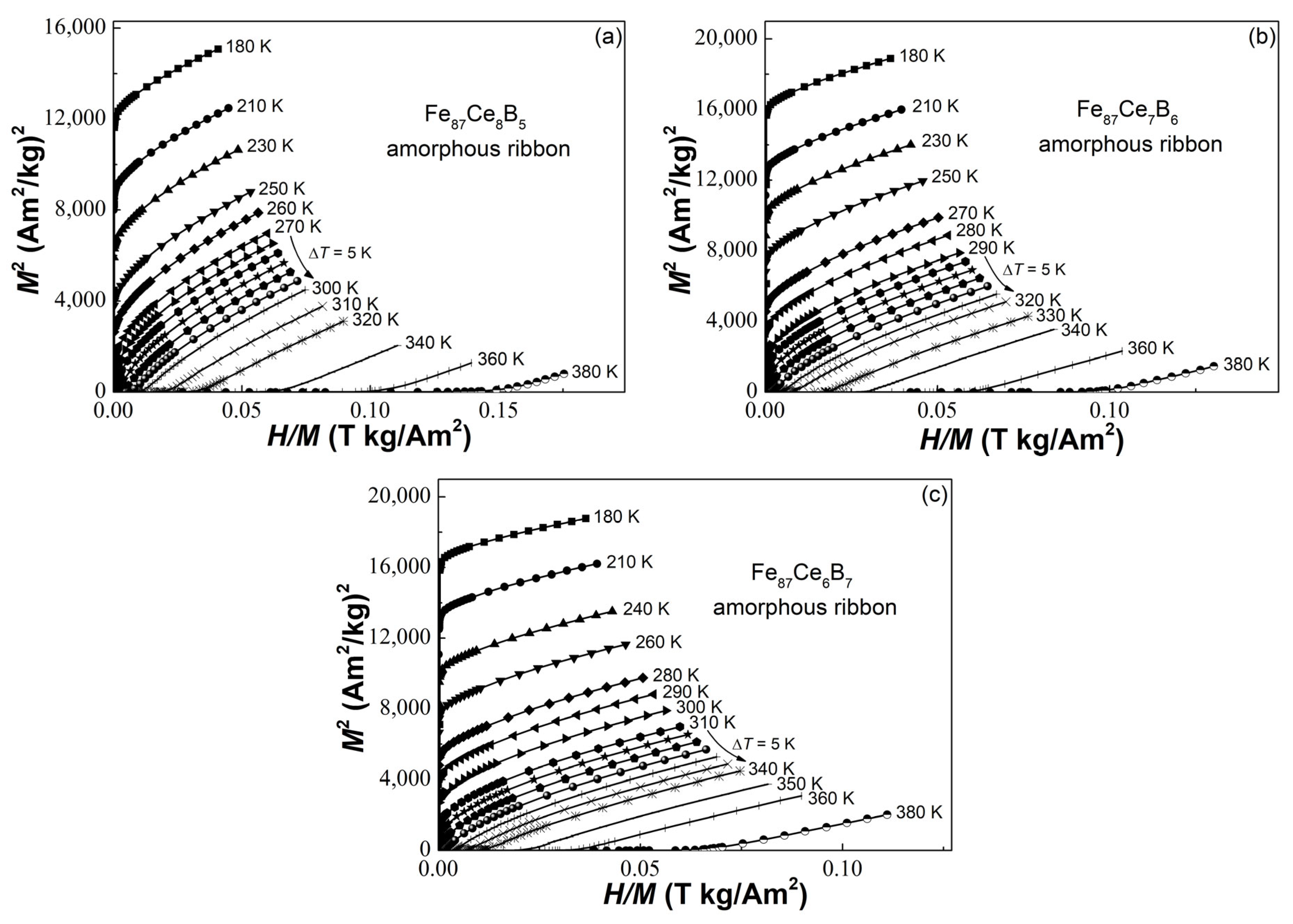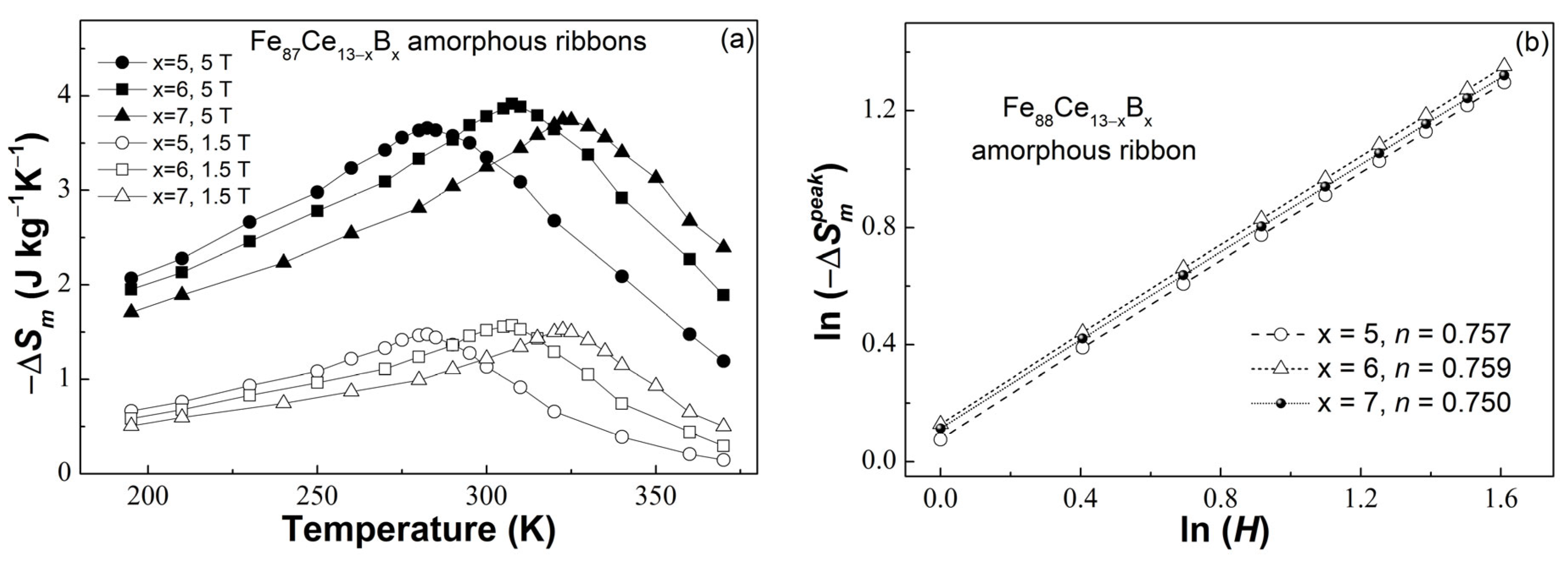Excellent Magnetocaloric Performance of the Fe87Ce13−xBx (x = 5, 6, 7) Metallic Glasses and Their Composite
Abstract
1. Introduction
2. Materials and Methods
3. Results and Discussion
4. Conclusions
- (i)
- The Trg and γ indicate that the GFA of the Fe87Ce13−xBx (x = 5, 6, 7) ribbons were increased with the addition of boron;
- (ii)
- All ribbons show soft magnetic properties with negligible coercivity at 180 K, and Tc of the Fe87Ce13−xBx (x = 5, 6, 7) amorphous ribbons is ~283 K for x = 5, ~305 K for x = 6, and ~323 K for x = 7, respectively. The increased Tc with the addition of boron may be due to the enhanced 3d–3d interaction between Fe atoms induced by the increase of boron content and the reduction of Ce content;
- (iii)
- The −ΔSmpeak of the Fe87Ce13−xBx (x = 5, 6, 7) amorphous ribbons first increases and subsequently decreases with the increase of boron content, which is supposed to be related to the competitive effect between the enhanced 3d–3d interaction by the addition of B content and the reduced total magnetic entropy by the decrease of Ce content;
- (iv)
- Both Arrott plots and the value of n at Tc suggest the typical second-order magnetic transition magnetocaloric behavior of the three ribbons. All the Fe87Ce13−xBx (x = 5, 6, 7) amorphous ribbons show rather excellent MCE than Fe-Zr-B-based metallic glasses.
Author Contributions
Funding
Institutional Review Board Statement
Informed Consent Statement
Data Availability Statement
Acknowledgments
Conflicts of Interest
References
- Chaudhary, V.; Chen, X.; Ramanujan, R.V. Iron and manganese based magnetocaloric materials for near room temperature thermal management. Prog. Mater. Sci. 2019, 100, 64–98. [Google Scholar] [CrossRef]
- Bruck, E. Developments in magnetocaloric refrigeration. J. Phys. D. Appl. Phys. 2005, 38, R381–R391. [Google Scholar] [CrossRef]
- de Oliveira, N.A.; von Ranke, P.J. Theoretical aspects of the magnetocaloric effect. Phys. Rep. 2010, 489, 89–159. [Google Scholar] [CrossRef]
- Franco, V.; Blázquez, J.S.; Ipus, J.J.; Law, J.Y.; Moreno-Ramírez, L.M.; Conde, A. Magnetocaloric effect: From materials research to refrigeration devices. Prog. Mater. Sci. 2018, 93, 112–232. [Google Scholar] [CrossRef]
- Gschneidner, K.A., Jr.; Pecharsky, V.K. Magnetocaloric Materials. Annu. Rev. Mater. Sci. 2000, 30, 387–429. [Google Scholar] [CrossRef]
- Giauque, W.F.; Macdougall, D.P. Attainment of temperature below 1° absolute by demagnetization of Gd2(SO4)3·8H2O. Phys. Rev. 1933, 43, 768. [Google Scholar] [CrossRef]
- Shen, B.G.; Sun, J.R.; Hu, F.X.; Zhang, H.W.; Cheng, Z.H. Recent Progress in Exploring Magnetocaloric Materials. Adv. Mater. 2009, 21, 4545–4564. [Google Scholar] [CrossRef]
- Pecharsky, V.K.; Gschneidner, K.A., Jr. Tunable magnetic regenerator alloys with a giant magnetocaloric effect for magnetic refrigeration from ~20 to ~290 K. Appl. Phys. Lett. 1997, 70, 3299–3301. [Google Scholar] [CrossRef]
- Pecharsky, V.K.; Gschneidner, K.A., Jr. Giant magnetocaloric effect in Gd5(Si2Ge2). Phys. Rev. Lett. 1997, 78, 4494–4497. [Google Scholar] [CrossRef]
- Miao, X.F.; Wang, W.Y.; Liang, H.X.; Qian, F.J.; Cong, M.Q.; Zhang, Y.J.; Muhammad, A.; Tian, Z.J.; Xu, F. Printing (Mn,Fe)2(P,Si) magnetocaloric alloys for magnetic refrigeration applications. J. Mater. Sci. 2020, 55, 6660–6668. [Google Scholar] [CrossRef]
- Pasquale, M.; Sasso, C.P.; Lewis, L.H.; Giudici, L.; Lograsso, T.; Schlagel, D. Magnetostructural transition and magnetocaloric effect in Ni55Mn20Ga25 single crystals. Phys. Rev. B 2005, 72, 094435. [Google Scholar] [CrossRef]
- Hashimoto, T.; Kuzuhara, T.; Sahashi, M.; Inomata, K.; Tomokiyo, A.; Yayama, H. New application of complex magnetic materials to the magnetic refrigerant in an Ericsson magnetic refrigerator. J. Appl. Phys. 1987, 62, 3873–3878. [Google Scholar] [CrossRef]
- Xia, L.; Tang, M.B.; Chan, K.C.; Dong, Y.D. Large magnetic entropy change and adiabatic temperature rise of a Gd55Al20Co20Ni5 bulk metallic glass. J. Appl. Phys. 2014, 115, 223904. [Google Scholar] [CrossRef]
- Bingham, N.S.; Wang, H.; Qin, F.; Peng, H.X.; Sun, J.F.; Franco, V.; Srikanth, H.; Phan, M.H. Excellent magnetocaloric properties of melt-extracted Gd-based amorphous microwires. Appl. Phys. Lett. 2012, 101, 102407. [Google Scholar] [CrossRef]
- Chen, L.S.; Zhang, J.Z.; Wen, L.; Yu, P.; Xia, L. Outstanding magnetocaloric effect of Fe88-xZr8B4Smx (x=0, 1, 2, 3) amorphous alloys. Sci. China. Phys. Mech. Astron. 2018, 61, 056121. [Google Scholar] [CrossRef]
- Gan, L.H.; Ma, L.Y.; Tang, B.Z.; Ding, D.; Xia, L. Effect of Co substitution on the glass forming ability and magnetocaloric effect of Fe88Zr8B4 amorphous alloys. Sci. China. Phys. Mech. Astron. 2017, 60, 076121. [Google Scholar] [CrossRef]
- Peng, J.X.; Tang, B.Z.; Wang, Q.; Bai, C.; Wu, Y.; Chen, Q.X.; Li, D.M.; Ding, D.; Xia, L.; Guo, X.L.; et al. Effect of heavy rare-earth (Dy, Tb, Gd) addition on the glass-forming ability and magneto-caloric properties of Fe89Zr7B4 amorphous alloy. J. Alloys Compd. 2022, 925, 166707. [Google Scholar] [CrossRef]
- Yu, P.; Zhang, J.Z.; Xia, L. Effect of boron on the magneto-caloric effect in Fe91-xZr9Bx (x = 3, 4, 5) amorphous alloys. J. Mater. Sci. 2017, 52, 13948–13955. [Google Scholar] [CrossRef]
- Waske, A.; Schwarz, B.; Mattern, N.; Eckert, J. Magnetocaloric (Fe-B)-based amorphous alloys. J. Magn. Magn. Mater. 2013, 329, 101–104. [Google Scholar] [CrossRef]
- Zhang, M.X.; Li, J.W.; Kong, F.L.; Liu, J. Magnetic properties and magnetocaloric effect of FeCrNbYB metallic glasses with high glass-forming ability. Intermetallics 2015, 59, 18–22. [Google Scholar] [CrossRef]
- Caballero-Flores, R.; Franco, V.; Conde, A.; Kiss, L.F. Influence of Mn on the magnetocaloric effect of nanoperm-type alloys. J. Appl. Phys. 2010, 108, 073921. [Google Scholar] [CrossRef]
- Min, S.G.; Kim, K.S.; Yu, S.C.; Lee, K.W. The magnetization behavior and magnetocaloric effect in amorphous Fe-Nb-B ribbons. Mater. Sci. Eng. A-Struct. Mater. Prop. Microstruct. Process. 2007, 449, 423–425. [Google Scholar] [CrossRef]
- Wang, X.; Wang, Q.; Tang, B.Z.; Ding, D.; Cui, L.; Xia, L. Effect of Mn Substitution Fe on the Formability and Magnetic Properties of Amorphous Fe88Zr8B4 Alloy. Metals 2021, 11, 1577. [Google Scholar] [CrossRef]
- Wang, X.; Wang, Q.; Tang, B.Z.; Ding, D.; Cui, L.; Xia, L. Magnetic and Magneto-Caloric Properties of the Amorphous Fe92-xZr8Bx Ribbons. Materials 2020, 13, 5334. [Google Scholar] [CrossRef]
- Wu, Y.B.; Wang, Q.; Tang, B.Z.; Pan, L.L.; Ding, D.; Xia, L. Outstanding glass formability and magneto-caloric effect of a Fe85Co3Zr5B4Nb3 metallic glass. J. Non-Cryst. Solids 2021, 566, 120885. [Google Scholar] [CrossRef]
- Yu, P.; Zhang, J.Z.; Xia, L. Fe87Zr7B4Co2 amorphous alloy with excellent magneto-caloric effect near room temperature. Intermetallics 2018, 95, 85–88. [Google Scholar] [CrossRef]
- Li, H.X.; Lu, Z.C.; Wang, S.L.; Wu, Y.; Lu, Z.P. Fe-based bulk metallic glasses: Glass formation, fabrication, properties and applications. Prog. Mater. Sci. 2019, 103, 235–318. [Google Scholar] [CrossRef]
- Inoue, A.; Takeuchi, A. Recent development and application products of bulk glassy alloys. Acta Mater. 2011, 59, 2243–2267. [Google Scholar] [CrossRef]
- Wang, C.H.; Wang, Q.; Tang, B.Z.; Zhou, X.; Ding, D.; Xia, L. Achieve good magneto-caloric response near the ambient temperature in a Fe86La7B5Ce2 amorphous ribbon. J. Magn. Magn. Mater. 2022, 547, 168954. [Google Scholar] [CrossRef]
- Li, A.L.; Wang, Q.; Tang, B.Z.; Yu, P.; Ding, D.; Xia, L. Magnetocaloric effect of the Fe87M8B5 (M = Zr, Ce) amorphous alloys. Mater. Sci. Eng. B-Adv. 2022, 286, 116033. [Google Scholar] [CrossRef]
- Turnbull, D. Under what conditions can a glass be formed? Contemp. Phys. 1969, 10, 473–488. [Google Scholar] [CrossRef]
- Lu, Z.P.; Liu, C.T. A new glass-forming ability criterion for bulk metallic glasses. Acta Mater. 2002, 50, 3501–3512. [Google Scholar] [CrossRef]
- Banerjee, S.K. On a generalized approach to first and second order magnetic transitions. Phys. Lett. 1964, 12, 16–17. [Google Scholar] [CrossRef]
- Hashimoto, T.; Numasawa, T.; Shino, M.; Okada, T. Magnetic refrigeration in the temperature range from 10 K to room temperature: The ferromagnetic refrigerants. Cryogenics 1981, 21, 647–653. [Google Scholar] [CrossRef]
- Oesterreicher, H.; Parker, F.T. Magnetic cooling near Curie temperatures above 300 K. J. Appl. Phys. 1984, 55, 4334–4338. [Google Scholar] [CrossRef]
- Zheng, X.N.; Wang, Q.; Yue, C.Y.; Li, A.L.; Ding, D.; Xia, L. Achieving higher magnetic entropy change peak at lower temperature by minor Ti substitution for Zr in the Fe88Zr8B4 metallic glass. Mod. Phys. Lett. B 2023, 37, 2350032. [Google Scholar] [CrossRef]
- Smaili, A.; Chahine, R. Composite materials for Ericsson-like magnetic refrigeration cycle. J. Appl. Phys. 1997, 81, 824. [Google Scholar] [CrossRef]
- Ma, L.Y.; Gan, L.H.; Chan, K.C.; Ding, D.; Xia, L. Achieving a table-like magnetic entropy change across the ice point of water with tailorable temperature range in Gd-Co-based amorphous hybrids. J. Alloys Compd. 2017, 723, 197–200. [Google Scholar] [CrossRef]
- Álvarez, P.; Gorria, P.; Llamazares, J.L.S.; Blanco, J.A. Searching the conditions for a table-like shape of the magnetic entropy in magneto-caloric materials. J. Alloys Compd. 2013, 568, 98–101. [Google Scholar] [CrossRef]





| Composition | Tg (K) | Tx (K) | Tl (K) | Trg | γ | Tc (K) |
| x = 5 | 651 | 741 | 1442 | 0.451 | 0.354 | 283 |
| x = 6 | 698 | 767 | 1443 | 0.483 | 0.358 | 305 |
| x = 7 | 701 | 777 | 1444 | 0.485 | 0.362 | 323 |
| −ΔSmpeak (J/(kg × K)) | ||||||
| 1 T | 1.5 T | 2 T | 3 T | 4 T | 5 T | |
| x = 5 | 1.08 | 1.48 | 1.84 | 2.49 | 3.09 | 3.66 |
| x = 6 | 1.14 | 1.56 | 1.94 | 2.63 | 3.28 | 3.88 |
| x = 7 | 1.12 | 1.52 | 1.89 | 2.56 | 3.17 | 3.75 |
Disclaimer/Publisher’s Note: The statements, opinions and data contained in all publications are solely those of the individual author(s) and contributor(s) and not of MDPI and/or the editor(s). MDPI and/or the editor(s) disclaim responsibility for any injury to people or property resulting from any ideas, methods, instructions or products referred to in the content. |
© 2023 by the authors. Licensee MDPI, Basel, Switzerland. This article is an open access article distributed under the terms and conditions of the Creative Commons Attribution (CC BY) license (https://creativecommons.org/licenses/by/4.0/).
Share and Cite
Zheng, S.-H.; Wang, Q.; Zhu, L.-Z.; Wang, P.-J.; Ding, D.; Tang, B.-Z.; Yu, P.; Yao, J.-L.; Xia, L. Excellent Magnetocaloric Performance of the Fe87Ce13−xBx (x = 5, 6, 7) Metallic Glasses and Their Composite. Materials 2023, 16, 4393. https://doi.org/10.3390/ma16124393
Zheng S-H, Wang Q, Zhu L-Z, Wang P-J, Ding D, Tang B-Z, Yu P, Yao J-L, Xia L. Excellent Magnetocaloric Performance of the Fe87Ce13−xBx (x = 5, 6, 7) Metallic Glasses and Their Composite. Materials. 2023; 16(12):4393. https://doi.org/10.3390/ma16124393
Chicago/Turabian StyleZheng, Shu-Hui, Qiang Wang, Li-Ze Zhu, Peng-Jie Wang, Ding Ding, Ben-Zhen Tang, Peng Yu, Jin-Lei Yao, and Lei Xia. 2023. "Excellent Magnetocaloric Performance of the Fe87Ce13−xBx (x = 5, 6, 7) Metallic Glasses and Their Composite" Materials 16, no. 12: 4393. https://doi.org/10.3390/ma16124393
APA StyleZheng, S.-H., Wang, Q., Zhu, L.-Z., Wang, P.-J., Ding, D., Tang, B.-Z., Yu, P., Yao, J.-L., & Xia, L. (2023). Excellent Magnetocaloric Performance of the Fe87Ce13−xBx (x = 5, 6, 7) Metallic Glasses and Their Composite. Materials, 16(12), 4393. https://doi.org/10.3390/ma16124393







